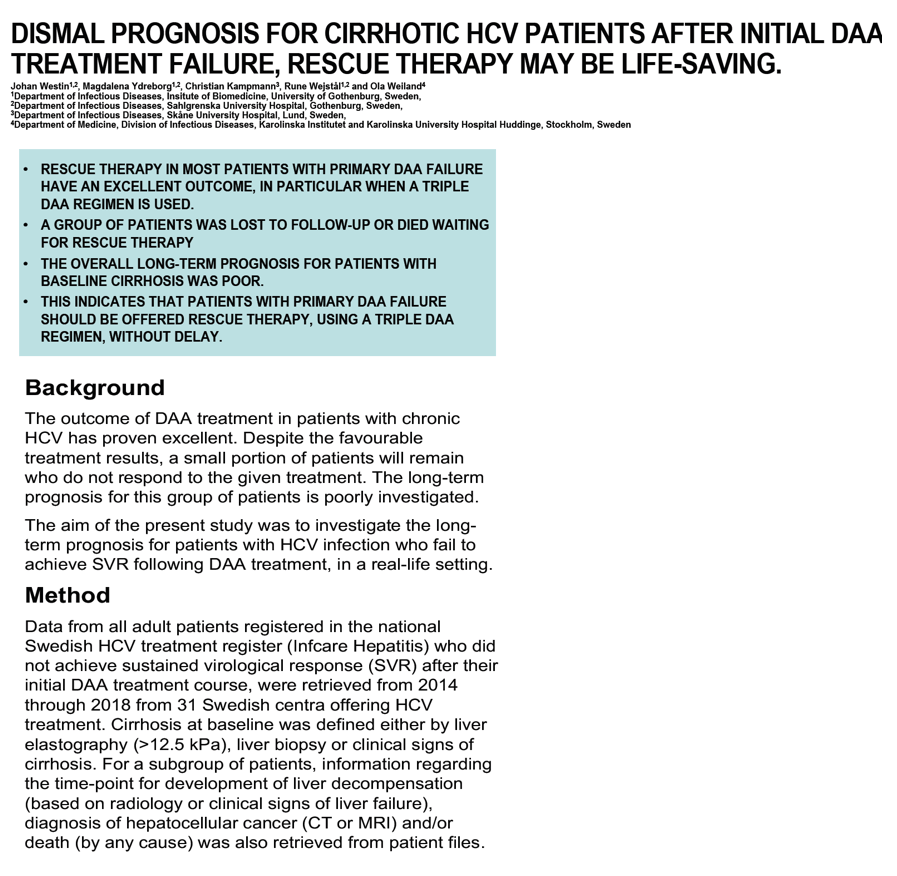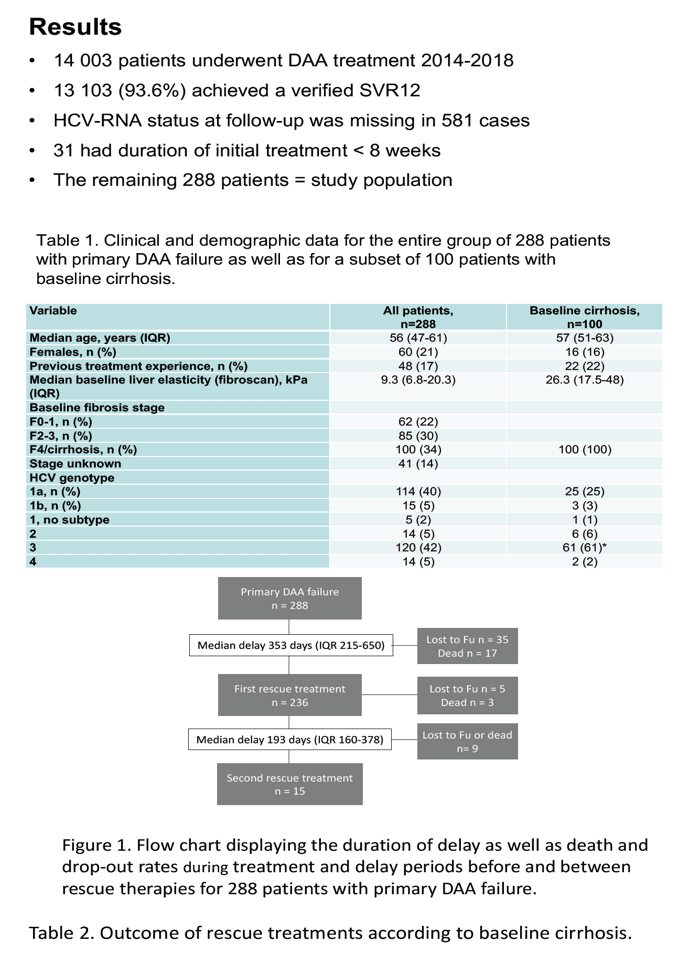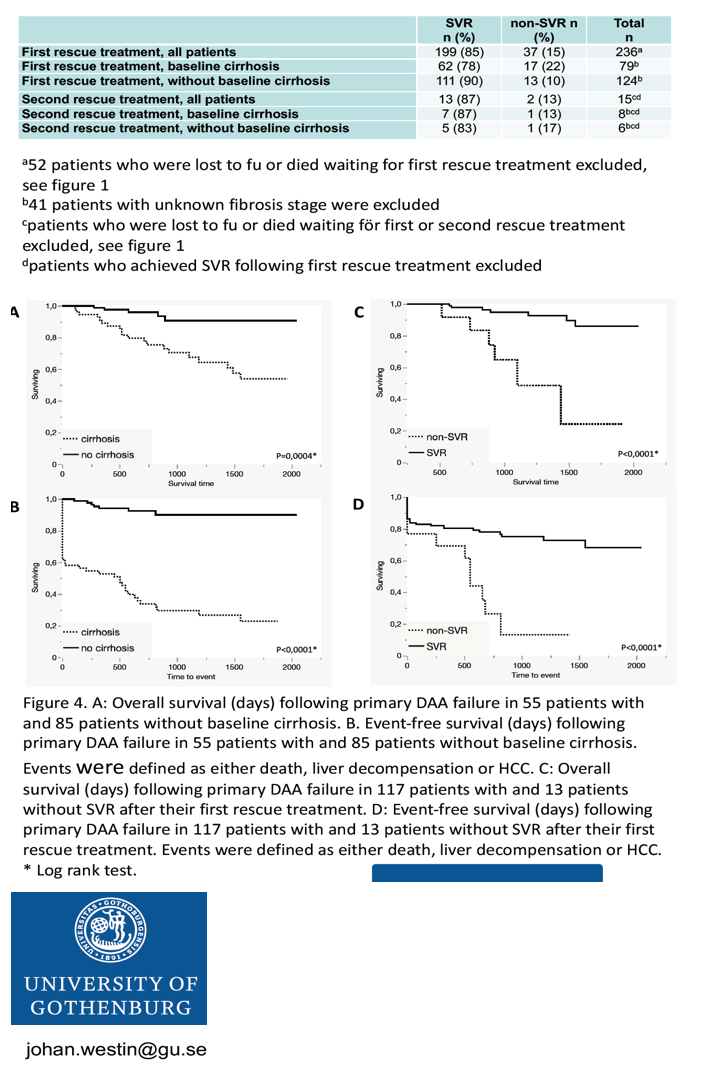 |
 |
 |
| |
Don't Delay Rescue 2nd Line HCV Therapy
"Dismal Prognosis" After First DAA Failure in People With Pretreatment Cirrhosis
|
| |
| |
EASL International Liver Congress 2022, London, June 22-26, 2022
Mark Mascolini
Overall long-term prognosis was "dismal" for people with HCV and cirrhosis whose first direct-acting antiviral (DAA) regimen failed to achieve sustained virologic response (SVR, according to analysis of 288 patients at the University of Gothenburg in Sweden [1]. People with cirrhosis whose first DAAs fail "should be offered rescue therapy, using a triple DAA regimen, without delay," the Gothenburg group urged.
Because the long-term prognosis of people who fail to attain SVR with their first DAAs is poorly understood, these investigators aimed to track outcomes in the small proportion of people with first-line DAA failure. They started with everyone in the Swedish HCV treatment register who did not attain SVR with their first DAA course from 2014 through 2018 at 31 Swedish centers, dividing this group into people without or with pretreatment (baseline) cirrhosis (liver elastography above 12.5 kPa, liver biopsy, or clinical signs).
Of the 14,003 people who started DAAs in 2014-2018, 13,103 (93.6%) attained verified SVR12. Among the people who did not reach SVR, follow-up status remained unknown for 581 people, and 31 had fewer than 8 weeks of first-line DAAs. The remaining 288 people made up the study population, and 100 of them had baseline cirrhosis.
For all 288 people and for the 100 with baseline cirrhosis, median age stood at 56 and 57, 21% and 16% were female, 17% and 22% had pre-DAA therapy, and median baseline liver elasticity by FibroScan was 9.3 and 26.3 kPa.
After first-line DAA failure, a median of 353 days (interquartile range [IQR] 215 to 650) passed before the first rescue regimen began. During that time, 35 people were lost to follow-up (stopped keeping appointments) and 17 died. During treatment with the first rescue regimen, 5 people were lost to follow-up and 3 died. Among people in whom the first rescue failed to attain SVR, there was a median delay of 193 days (IQR 160 to 378) before a second rescue regimen began and 9 more people were lost to follow-up or died. Fifteen people had a second rescue regimen during the study period.
In the outcome analysis, the researchers excluded 52 people who were lost to follow-up or died while waiting for a first rescue regimen. That left 236 people, 199 (84%) of whom attained SVR with their first rescue and 37 (16%) who did not. Among people who had baseline cirrhosis and a first rescue regimen, 78% reached SVR with rescue therapy and 22% did not. Among people without baseline cirrhosis who had a first rescue regimen, 90% attained SVR and 10% did not.
Among 15 people who had a second rescue regimen, 13 attained SVR and 2 did not. Among people with baseline cirrhosis, 7 reached SVR with their second rescue regimen and 1 did not. Among people without baseline cirrhosis, 5 reached SVR with their second rescue regimen and 1 did not.
After first-line DAA failure, overall survival was significantly shorter in 55 people with baseline cirrhosis than in 85 without baseline cirrhosis (P = 0.0004). In these same 140 people, event-free survival was significantly shorter in the group with baseline cirrhosis (P < 0.0001). In 117 people with SVR and 13 without SVR after their first rescue regimen, overall survival proved significantly shorter in the non-SVR group (P < 0.0001). And in these same 130 people, event-free survival was significantly shorter in the non-SVR group (P < 0.0001).
The researchers concluded that DAA rescue therapy yields excellent results after first-line DAA failure, particularly in people receiving a 3-drug regimen. But "overall long-term prognosis for patients with baseline cirrhosis was poor," and some patients fell out of care or died waiting for rescue therapy. Together these findings led the Gothenburg team to stress the urgency of prompt rescue therapy with a triple DAA regimen after primary DAA failure.
Reference
1. Westin J, Ydreborg M, Kampmann C, et al. Dismal prognosis for cirrhotic HCV patients after initial DAA treatment failure, rescue therapy may be life-saving. EASL International Liver Congress 2022, London, June 22-26, 2022. Abstract FRI382.



|
| |
|
 |
 |
|
|